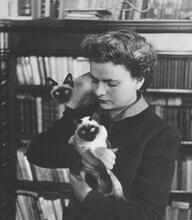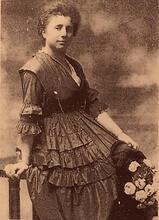Natalia Ginzburg
Born in Palermo, Italy, in 1916, Natalia Ginzburg published her first novella, I Bandini, at the age of eighteen in the distinguished Florentine periodical Solaria. She was the first to translate Marcel Proust’s Du côté de chez Swann into Italian. In 1942 her first novel, La strada che va in città (The Road to the City), was published. In 1963 Ginzburg won the Strega Prize for her own humorous autobiographical work, Lessico Famigliare (Family Sayings), which dealt with her family’s anti-fascist life in Turin. In the 1980s Ginzburg became politically active, joining the Communist Party and being elected to Parliament as an independent left-wing deputy in 1983 and 1987. She died in Rome in 1991 at the age of seventy-five.
Early Life and Family Background
Arguably the most important woman writer of post-World War II Italy, Natalia Ginzburg was born on July 14, 1916, in Palermo (Sicily), where her Jewish Trieste-born father, Giuseppe Levi, who later achieved fame as a biologist and histologist, was at the time a lecturer in comparative anatomy. His non-Jewish wife, Lidia Tanzi, was the daughter of a socialist lawyer, Carlo Tanzi, a friend of Filippo Turati (1857–1932), one of the founders of the Italian Workers Party. Other family members included her uncles, the neuropsychiatrist Eugenio Tanzi (1886–1934) and the musicologist Silvio Tanzi. Giuseppe’s brother, Cesare, was a theater critic and academician. Giuseppe, a domineering father, became a dominant figure in his daughter’s life, inspiring both guilt and fear but also hero-worship, enormous admiration, and a desire to be like him.
In 1919 Giuseppe Levi was appointed professor at the University of Turin. Here Ginzburg grew up in a cultural, anti-fascist milieu, her parental home becoming a meeting place for intellectuals. Anna Kuliscioff was a close friend of Lidia (Tanzi) Levi. However, the fact that the family were anti-fascist, anti-monarchist, and atheist led to their being excluded from the mainstream. Rather than attend primary school, Ginzburg studied at home with her mother; in 1927 she joined the Vittorio Alfieri high school. In 1935 she began university studies in literature, specializing in classics, but never completed her degree.
At the age of eighteen Ginzburg published her first novella, I Bandini, in the distinguished Florentine periodical Solaria, following it with works in Il Lavoro and Letteratura. She was the first to translate Marcel Proust’s Du côté de chez Swann into Italian. Completed in 1937, it was published by Einaudi only in 1946, but its autobiographical nature particularly influenced Ginzburg’s own writings. As her own humorous, autobiographical work, Lessico Famigliare (Family Sayings, 1963) testifies, she identified with Proust, having herself as a child felt profoundly marginalized. She always found it necessary to bring the reader back to her childhood as a point of departure for her work.
Early Career and World War II
On February 12, 1938 (the year in which the racial laws were promulgated), she married editor and political activist Leone Ginzburg, a Russian Jew from Odessa who headed Turin’s clandestine anti-fascist movement, Giustizia e Liberta, in which Ginzburg’s father and her three brothers, Gino, Mario, and Alberto were also members. Leone, a brilliant scholar in Slavic studies, lectured on Russian literature at Turin University and worked for the Einaudi publishing house. In 1940, when Leone was interned in Pizzoli, a village in the Abruzzo region, Ginzburg followed him with their two small sons, Carlo (b. 1939, professor of Italian Renaissance Studies at UCLA) and Andrea. There her daughter Alessandra was born in 1943.
In 1942 Einaudi published Natalia Ginzburg’s first novel, La strada che va in città (The Road to the City), under the pseudonym of Alessandra Tornimparte. On July 26, 1943, when Leone’s confinement to Pizzoli ended, he moved first to Turin and then to Rome, where he again participated in underground resistance to the fascist regime. Ginzburg and the children joined him at the beginning of November, but on November 20 he was arrested at a clandestine press. Transferred to the German branch of the Regina Coeli prison, he was tortured and killed on February 5, 1944. Throughout his imprisonment, Ginzburg was not allowed to see him.
After taking refuge for a time at the Ursuline convent in the Nomentano quarter of Rome, Ginzburg and her children moved to Florence, where they stayed with one of her maternal aunts until the city was liberated in November 1944. Moving back to Rome, she was employed as an editor by Einaudi, for whom she continued to work after returning to Turin to live in her parents’ old home, which she loved deeply. While Einaudi introduced such writers as Cesare Pavese and, later, Elsa Morante and Italo Calvino, in 1947 Ginzburg rejected Primo Levi’s first book on his Holocaust experience, Se questo è un uomo (If This Is a Man, 1947).
Later Nostalgic Writings
In 1950 Natalia Ginzburg married Gabriele Baldini, a professor of English literature in Trieste, but she continued to reside in Turin until the couple moved to Rome in 1952, the year in which she published her novel Tutti i nostri ieri (All Our Yesterdays). There followed her most fruitful years, during which she wrote three major works: Valentino (1957), Le voci della sera (1961), and Le piccole virtù (1962). In 1959 she moved to London, where her husband headed the Italian Cultural Center until 1961. In 1963 she won the Strega Prize for Lessico Famigliare, which deals with her own family’s anti-fascist life in Turin, using commonplace, conversational language but presenting everyday experience in an original and poetic manner. It is now mandatory reading in Italian schools. In 1965 Natalia Ginzburg wrote the comedy Ti ho sposato per allegria (I Married You for Fun) for the actress Adriana Asti, who performed it with great success. She followed it in 1968 with two more plays, L’inserzione and La segretaria.
Natalia Ginzburg’s father died in 1965 and Baldini in 1969. The novels and essays she wrote in the 1960s and later, which nostalgically recall the events of her life in various locations, include Mai devi domandarmi (You Must Never Ask Me, 1970), Vita Immaginaria (Imaginary Life, 1974), and Famiglia (Family, 1977).
Political Activism
In the 1980s Natalia Ginzburg became politically active, joined the Communist Party, and was elected to parliament as an independent left-wing deputy in 1983 and 1987. Animated by a profound sense of justice, she engaged with passion in various humanitarian issues, such as the lowering of the price of bread, support for Palestinian children, legal assistance for rape victims and reform of adoption laws. However, she did not feel at ease in party politics and soon resigned from the Communist Party.
Death and Legacy
Natalia Ginzburg, who constantly wrote about strong women, was herself strong. The children of her second marriage were born handicapped. A son, born in 1959, died at the age of one, but Ginzburg cared for her daughter Susanne (b. 1954) until she herself died of cancer in her beautiful home in Rome in the night of October 6–7, 1991. In 1999 Einaudi posthumously published her last work, È difficile parlare di sè (It’s Hard to Talk about Yourself), a text based on a series of radio talks in which Natalia Ginzburg spoke about her life and her literary work. Presenting a vivid portrait of the writer in her own words, the book describes the factors—politics, publishing, literature and family—that shaped her remarkable life.
Modest and intensely reserved, Ginzburg never shied away from the traumas of history, whether writing about the Turin of her childhood, the Abruzzi countryside or contemporary Rome—all the while approaching those traumas only indirectly, through the mundane details and catastrophes of personal life.
SELECTED WORKS BY NATALIA GINZBURG
Novels
La strada che va in città (1942); È stato così (1947); Tutti I nostri ieri (1952); Valentino (1957); Le voci della sera (1961); Piccole virtù (1962); Lessico famigliare (1963); Caro Michele (1973); La vita immaginaria (1974); Famiglia (1977).
Theater
Ti ho sposato per allegria (1965); L’inserzione and La segretaria (1968).
Essays
La Famiglia Manzoni (The Manzoni Family, 1983); Serena Cruz o la vera giustizia (Serena Cruz, or True Justice, 1990).
Acocella, Joan. “Rediscovering Natalia Ginzburg.” The New Yorker. Condé Nast, 19 July 2019. https://www.newyorker.com/magazine/2019/07/29/rediscovering-natalia-gin….
Borrelli, Clara. Notizie ddi Natalia Ginzburg. Napoli: L’orientale, 2002.
Borri, Giancarlo. Natalia Ginzburg. Rimini: 1999.
Bullock, Allan. Natalia Ginzburg: Human Relationship in a Changing World. New York: 1991.
Byron, Tsippy Levin. “Sediments of Complexed Jewish Identity in Natalia Ginzburg’s Writings.” In Around the Point: Studies in Jewish Literature and Culture in Multiple Languages, ed. Ber Kotlerman, Hillel Weiss, Roman Katsman, 285-299. Newcastle Upon Tyne: Cambridge Scholars Publishing, 2014.
Castronuovo, Nadia. Natalia Ginzburg: Jewishnesss as Moral Identity. Leicester: Troubador Pub, 2010.
Di Genova, Arianna. Natalia Ginzburg: vocazione scrittrice. Rome: 2018.
“An Interview with Natalia Ginzburg.” Interview by Peg Boyers. Salmagundi 96 (Fall 1992).
Jeannet, Angela M. Natalia Ginzburg: A Voice of the Twentieth Century. Toronto: 2000.
Pflug, Maja. Natalia Ginzburg, eine Biographie. Berlin: 1995.
Picarazzi, Teresa L. Maternal Desire: Natalia Ginzburg’s mothers, daughters, and sisters. London: Associated University Presses, 2002.
Sehgal, Parul. “Reintroducing Natalia Ginzburg, One of the Great Italian Writers of the 20th Century.” The New York Times. The New York Times Company, 18 June 2019. https://www.nytimes.com/2019/06/18/books/review-dry-heart-happiness-as-….
Zarin, Cynthia. “Hiding in Plain Sight: Natalia Ginzburg’s Masterpiece.” The New Yorker. Condé Nast, 22 June 2017. https://www.newyorker.com/books/page-turner/hiding-in-plain-sight-natal….




